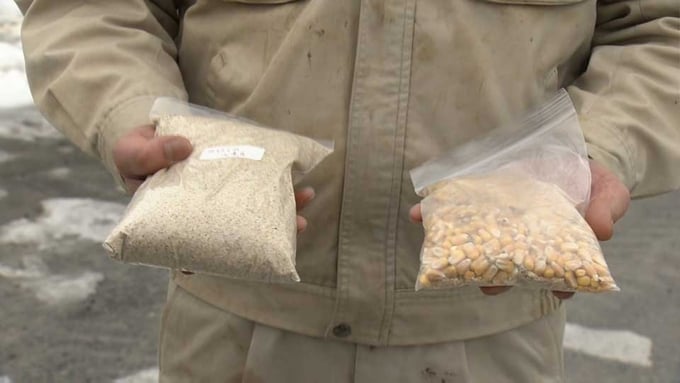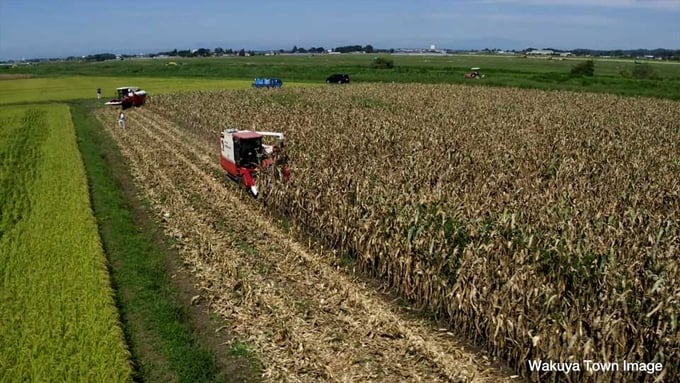May 24, 2025 | 12:08 GMT +7
May 24, 2025 | 12:08 GMT +7
Hotline: 0913.378.918
May 24, 2025 | 12:08 GMT +7
Hotline: 0913.378.918

The pigs eat feed that is 40% corn and 30% rice, both domestically produced.
Farmers in one part of northern Japan are addressing the problem by producing their own feed for livestock, instead of relying on shipments from overseas. Domestically produced corn is expected to help cut costs and also ensures a stable and reliable supply.
Special diet for pigs
For the past few months, the pigs at the Shiwahime Swaine farm in Miyagi Prefecture, northern Japan, have consumed a diet comprised mostly of corn and rice. Everything they eat is grown in Japan.
Farmer Ishikawa Teruyoshi is planning to put 1,000 of his pigs up for sale, and he will advertise the fact they were "raised only on domestic feed". It's a selling point that also marks a shift in methods.
Across Japan, about 80 percent of animal feed is imported. Prices are now 50 percent higher than two years ago.
In terms of overall food self-sufficiency, Japan produces just 38 percent of what its population consumes in calories, the lowest rate among the Group of Seven nations.
Ishikawa says soaring costs and supply concerns prompted him to make a change. "Japan's food self-sufficiency rate is too low. I think it is important to focus on domestic production, including corn farmers, and livestock farmers like me."
Corn a less labor-intensive crop
The corn for Ishikawa's pigs comes from a neighboring town, Wakuya. Farmers there harvested the first crop just last year. Town officials had encouraged them to turn to corn because not only had it become more expensive, but it requires less work than rice.

Four management bodies oversaw the first year of corn production, harvesting a total of 80 tons.
As is the case in most of rural Japan, the number of people available for agriculture work is declining due to an aging population, and the farmers often feel overworked.
Town official Fujisaki Koji explains that "rice is the mainstay crop for the town, but it requires a lot of work by the farmers. Corn production is less labor intensive, so that's why we decided to introduce it".
Farmers who switched from rice to corn could use equipment they already had, and they received free technical advice from agriculture experts.
The number of working hours needed to produce corn is about one-ninth of that needed for rice. Farmers in Wakuya hope this year's crop will yield more, better quality corn.
Oikawa Tatsuya, one of the farmers involved, notes that while government subsidies make it worthwhile now, in the longer term, corn has potential to be profitable. He also expects the stalks and other parts of the plants will nourish the soil.
Oikawa supports the home-grown shift: "I think it would be ideal for Japanese farmers to produce corn for feed for domestic livestock".
Using farmland more effectively
Tohoku University professor Ishii Keiichi is a global agriculture expert. He says growing corn for feed is an effective way to increase Japan's self-sufficiency. He points out that in Japan, farmland is limited and often narrow in shape.
On a per-capita basis, Japan has a very small amount of farmland compared with other G7 countries. Ishii says that means it's essential to use the land as effectively as possible. He says growing corn for livestock feed could prove vital to protecting national food security.
"Three things will be important to maintain domestic corn production, instead of relying on imported feed again," he says. "One is consumer interest in domestically-fed pork, beef, and chicken. Second, further government support may be needed, and third, farmers need to improve quality and yields."
Aiming for self sufficiency
There are several dairies in Wakuya, and town officials hope the cows may also be able to subsist on locally grown corn. The animals' manure can be used to fertilize the soil used for crops, adding to a cycle of self-sufficiency.
Ministry of Agriculture figures show domestic production of corn used for livestock feed is expanding rapidly. In 2021, about 8,000 tons was harvested, more than four times the amount produced seven years ago. Officials regard each ear of locally-produced corn as a step toward better national food security.
(NHK)

(VAN) Alt Carbon has raised $12 million in a seed round as it plans to scale its carbon dioxide removal work in the South Asian nation.

(VAN) Attempts to bring down the price of the Japanese staple have had little effect amid a cost-of-living crisis.

(VAN) Fourth most important food crop in peril as Latin America and Caribbean suffer from slow-onset climate disaster.

(VAN) Shifting market dynamics and the noise around new legislation has propelled Trouw Nutrition’s research around early life nutrition in poultry. Today, it continues to be a key area of research.

(VAN) India is concerned about its food security and the livelihoods of its farmers if more US food imports are allowed.

(VAN) FAO's Director-General emphasises the need to work together to transform agrifood systems.

(VAN) Europe is facing its worst outbreak of foot-and-mouth since the start of the century.